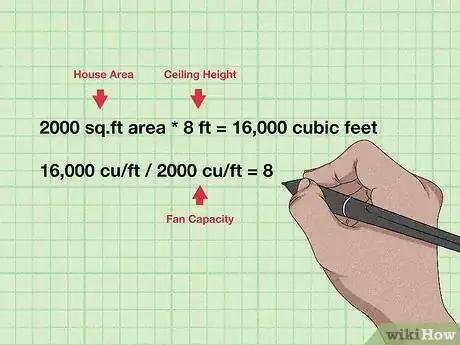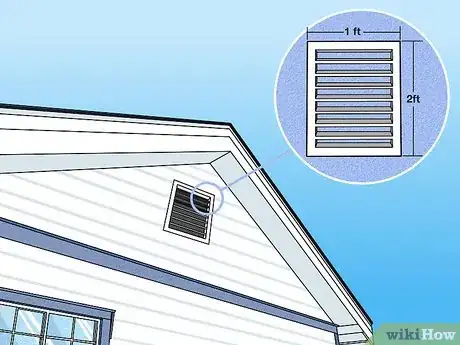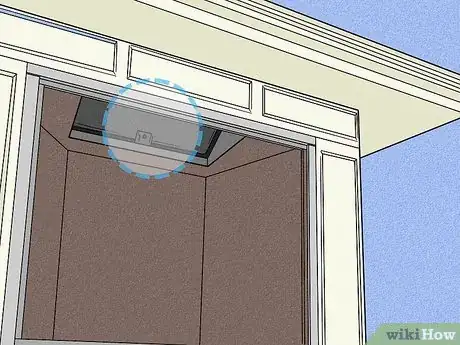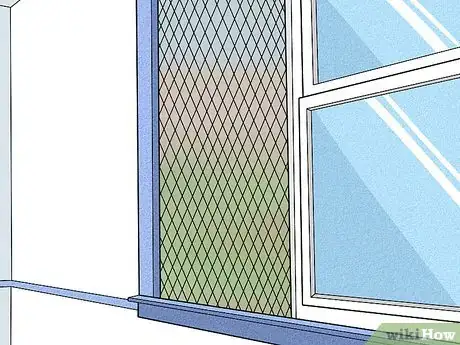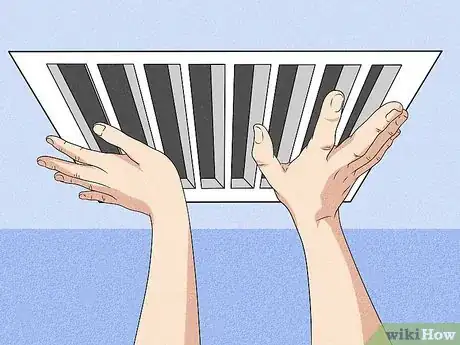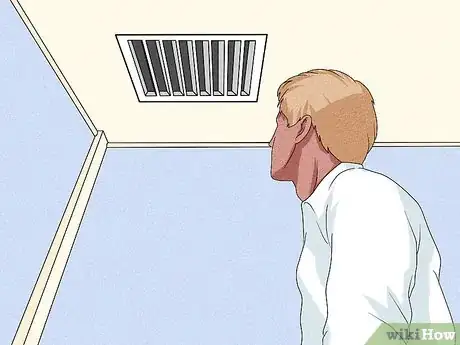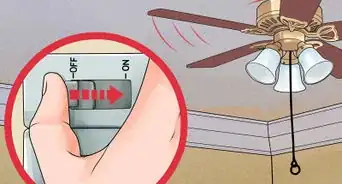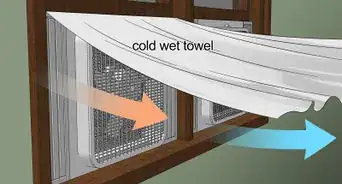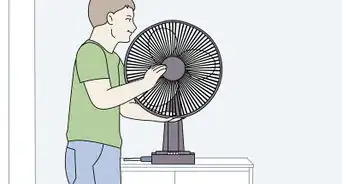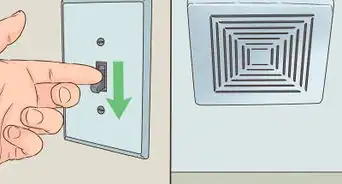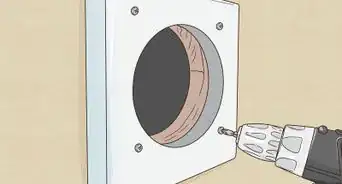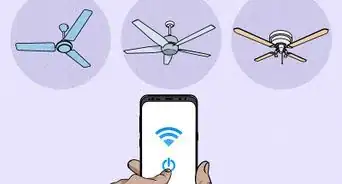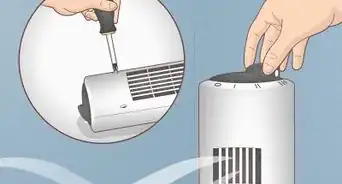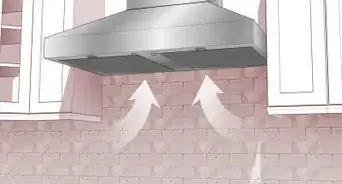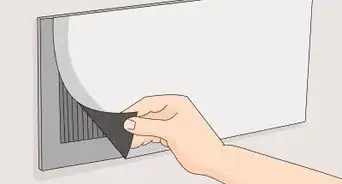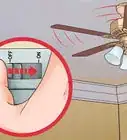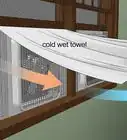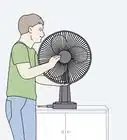This article was co-authored by Walter Brant. Walter Brant is a wikiHow community member and contributor who has been repairing and restoring houses with over 30 years of experience. He works with homeowners to make a wide variety of improvements to make their homes more comfortable and liveable.
This article has been viewed 214,344 times.
Using a whole-house fan properly can lower heating and cooling costs, reduce indoor allergens, and freshen the atmosphere of your home. Whole-house fans work by moving hot air out through gables or vents and drawing cooler air in. Whole-house fans therefore don't work very well when the outdoor temperature is much higher than the indoor temperature or when the outdoor humidity is high. New products have temperature and humidity sensors to add comfort.[1]
Steps
-
1Determine the size of the fan your home will need. Calculate the square footage of your home. Most whole-house fan manufacturers will list the capability of the fan to the square footage of your house. Some believe a complete change of the home's air should be accomplished every 3 or 4 minutes.
- Many fans include a CFM (Cubic Feet per Minute) rating. The greater the CFM value, the more air it can move. Simply divide your home's cubic feet by the fan's CFM rating to result in the number of minutes to exchange the air. [2]
- Consider that larger value CFM fans often have a larger physical size and/or higher rotational speed. As a result, they may be more noisy than lower value CFM types. Noise levels might also dictate where in the home the fan should be installed. A 2000 square foot home with 8 foot (2.4 m) high ceilings will, in theory, have all the air in the house completely changed in 8 minutes with a 2000 CFM fan (and windows open in each room). Likewise, a 4000 CFM fan will do it in as little as 4 minutes!
- Here's how one arrives at those figures. A 2000 CFM fan moves 2000 cubic foot volume of air in a minute. A 2000 square foot house with an 8 foot (2.4 m) high ceilings has 16,000 cubic feet of space (2,000 sq/ft area * 8 ft = 16,000 cubic feet). 16,000 cubic feet of space divided by the capacity of the fan, 2,000 cubic feet per minute, equals 8 minutes (16,000 cu/ft volume of air divided by 2,000 cu/ft of air moved per minute = 8 minutes to move that volume of air).
-
2Ensure that the home has at least 1.5 times the area for discharge as the opening you cut into the ceiling for the fan. The air being drawn up by the whole-house fan needs to be discharged somewhere, and you want that process to move smoothly.
- Example: a 2' X 2' opening for a fan results in 4 sq Ft. So, this 4 sq Ft X 1.5 = 6 sq Ft. Look around your attic. If you have 2 gable vents that are 1' x 2' = 2 sq Ft each, equaling only 4 sq Ft total. You probably have screens over them, so knock off 20% to 30% from 4 sq ft and you're down to around 3 feet (0.9 m). If you do not have adequate exhaust vent area, add some.[3]
- Ridge vent, soffit vents or enlarge the existing gable end vents are ways to obtain adequate exhaust ventilation area. Deduct for any and all blockages (screens, slats, lattice, etc). Generally, 10 sq Ft of attic discharge area is more than sufficient per fan in residential applications.
- That said, only very largest of homes would require multiple fans, and that is only when many windows are open and the resulting breeze is not satisfactory. Of course, closing windows increases the air flow (CFM) through those that are left open. More on this below.
Advertisement -
3Determine where the best intake locations are (windows or doors). These locations will have screens. Locations without screens are unsuitable. The fan should not be behind a door, but rather in a common hallway.
-
4Close the damper on the fireplace. If the damper is left open, outside air will be drawn down the chimney, bringing in soot and odor.[4]
-
5Open only the windows that have screens in the room(s) in which you are in. A 2000 CFM whole house fan will try to move 2000 CFM of air. This fan is limited only by the fan's 2000 CFM rating and the amount of area to intake (windows) and discharge (gable & ridge vents, etc) air area. Pulling that 2000 CFM through 2 or 3 windows instead of 10 windows results in a much stronger breeze.
- Let's do the math: 2000 CFM via 10 windows = 200 CFM per window. Now, close all but the 4 windows of the rooms you're in. 2000 CFM via 4 windows = 500 CFM per window (If windows are large enough)! That's a big difference. It's this breeze that creates the evaporative cooling of the skin.
- Moving air in an unoccupied room for hours doesn't make it feel cooler than it would if you had just entered it and then opened its windows. You can turn this into cash in electric bill savings by running the fan at a lower speed with 2 or 3 open windows instead of high speed with 10+ open windows.
- Don't run the fan when no one is home, as this just wastes electricity. The instant the fan is turned on, it creates a breeze that immediately cools you down. You can't get that kind of instant relief when you turn on an air conditioner.
- Maximize your savings: Windows that are open on the shaded side of a house will bring in much cooler air than those open above a sun drenched blacktop.
-
6Consider adding additional vents for the attic space. Allowing hot air trapped anywhere in the attic out prevents that heat from radiating downward through the ceiling into the living space, and reduces cooling load.
- Turbine ventilators work great, but strong winds can cause a downdraft and create static pressure, which will destroy the fan's ability to exhaust the home's air.
- Under eave vents are inexpensive to buy, inexpensive to mount, and provide a great way to exhaust the air. If your house has eaves, mount as many as possible under the eaves to allow proper ventilation. This is the best way to exhaust, as the effects are twofold: The first is that hot stale attic air is exhausted out, and second, with under eave vents the air travels along the roof line and down, which provides cross-ventilation for the attic itself. These are much easier to add than a ridge vent or powered attic ventilator.
-
7Be safe. Have your work permitted and inspected. Most localities observe the National Electrical Code[5] or some derivative of it. Follow your local code.
- If you insist on doing it yourself, make sure you install a service switch in the attic if it is possible to work on the fan from the attic space. An outlet nearby would probably come in handy to plug in a drop light or power tool.
Expert Q&A
-
QuestionCan you run a whole house fan with the windows closed?
 Walter BrantWalter Brant is a wikiHow community member and contributor who has been repairing and restoring houses with over 30 years of experience. He works with homeowners to make a wide variety of improvements to make their homes more comfortable and liveable.
Walter BrantWalter Brant is a wikiHow community member and contributor who has been repairing and restoring houses with over 30 years of experience. He works with homeowners to make a wide variety of improvements to make their homes more comfortable and liveable.
Handyman You should open the windows in the rooms you're using to help cool them down faster.
You should open the windows in the rooms you're using to help cool them down faster. -
QuestionCan I run a standing room fan along with the whole house fan?
 Community AnswerIf by "room fan" you mean ceiling or floor fan, then yes. However, it's not recommended to operate your HVAC system fan at the same time time as the whole-house fan.
Community AnswerIf by "room fan" you mean ceiling or floor fan, then yes. However, it's not recommended to operate your HVAC system fan at the same time time as the whole-house fan. -
QuestionDo I need to leave the wooden door of the attic open while running an attic fan?
 Community AnswerNo, do not leave the wooden door or access hatch to the attic open when running the whole-house fan. Remember, the fan works by pulling air through windows from outside and pushing it out of your attic vents. Leaving an attic door open would push that air back into the house and defeat the purpose of the system.
Community AnswerNo, do not leave the wooden door or access hatch to the attic open when running the whole-house fan. Remember, the fan works by pulling air through windows from outside and pushing it out of your attic vents. Leaving an attic door open would push that air back into the house and defeat the purpose of the system.
Warnings
- More attention to filters in your home will be needed due to the increased pollen, dust, etc being drawn into the space.⧼thumbs_response⧽
- It's not a good idea for people with allergies or asthma to utilize a whole-house fan during spring, or any other time of plant and weed germination. A sudden onslaught of outdoor air can wreak havoc on allergies. Check with your doctor first. There are filters that are available for your window that you can buy to prevent such. Check operation of your gas powered hot water heater - if the whole-house fan is sucking the exhaust back down from the chimney, you need more windows open.⧼thumbs_response⧽
References
About This Article
To use a whole house fan, start by opening up any screened doors and windows in the room you'll be in. Avoid opening windows or doors without screens since they won't work with a whole house fan. Next, close the damper on your fireplace if you have one so that soot and odors aren't drawn down into your house. Finally, turn on the fan so cool air from outside is drawn in through the open windows and doors. To learn how to choose the right whole house fan for your home, keep reading!
